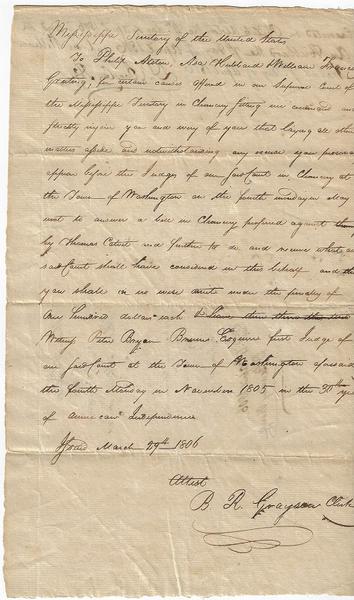Mississippi Territory Manuscript Summons

MANUSCRIPT SUMMONS ISSUED BY BEVERLY R. GRAYSON AND EXECUTED ON PHILIP ALSTON, ET. AL. BY SHERIFF DANIEL BEASLEY - MARCH 29, 1806
Sheriff Daniel Beasley Delivers a Summons in Mississippi Territory, 1806. Mississippi Territory was born in 1798, three years after Spain signed the Treaty of Madrid that ceded its possessions north of West Florida to the United States. At first, the formal territory was little more than a narrow strip between the Mississippi and Chattahoochee rivers, but in 1804 an act of Congress more than doubled its size by incorporating areas ceded by the state of Georgia in the aftermath of the Yazoo land fraud. Finally, the annexation of the Mobile District from West Florida in 1812 brought the territory to its full extent, including all of those lands that would soon become the states of Mississippi and Alabama in 1817 and 1819, respectively. During the 20 years of its existence, Mississippi Territory was a training ground for statesmen, a boon for planters and speculators, and a haven for scoundrels. This rare summons--issued during a dispute over land between Philip Alston and Thomas Calvit--offers intriguing examples of each. The summons itself, headed “Mississippi Territory of the United States” and addressed to Philip Alston and two of his associates, is entirely in the hand of Beverly R. Grayson (1782-1843). Grayson, who has also signed the document in his capacity as Clerk of the Supreme Court, hailed from a prominent Virginia family and had moved to Mississippi as a young man. Later, he was appointed auditor of public accounts for the territory, and after Mississippi was admitted into the Union as its 20th state, he served Adams County as Representative in the legislature from 1820 to 1821. He was a prosperous planter long active in the civic affairs of Natchez. The subject of the document was a land dispute between Alston, the defendant, and plaintiff Thomas Calvit. Calvit (1748-1821) was a wealthy plantation owner who had come to Mississippi from North Carolina in 1785 after rendering “distinguished services in the North West Campaign with George Rogers Clarke against the British, Indians and Tories” (Stanfill 1991:276). His home on Cole’s Creek, about 15 miles from Natchez, was known as Calviton. It was there, in 1807, that Colonel Aaron Burr tendered his unconditional surrender to the Secretary and Acting Governor of Mississippi Territory, Cowles Mead. Burr would later escape, but his arrest at Calviton effectively ended his attempt to create a personal empire in the center of North America. Philip Alston was the son of Philip Alston, Sr., a notorious counterfeiter who had fled to Natchez from North Carolina in 1772 or 1773, where he soon became a prosperous landowner and planter. But in 1781, he and his brother led a revolt against Spanish authorities, who were to take possession of West Florida, including Natchez, in 1783 under the terms of the Treaty of Paris. The Alston’s rebellion failed; John was taken as prisoner, and Philip fled north to the Cumberland and apparently continued his counterfeiting activities, even spending several months in hiding at Cavein-Rock, Illinois. In the 1790s, after Spain ceded West Florida to the United States, Philip returned to Natchez with his family to find that the Spanish government had sold those lands he abandoned to Thomas Calvit. Philip’s sons--among whom was Philip, Jr., the defendant here--had occupied the land on their return. Calvit demanded (and later won) their removal. Yet of all the Mississippi pioneers involved with this document, none played as important a role in southern history, though for unfortunate--if not altogether tragic--reasons, as the sheriff of Washington County, Daniel Beasley, who delivered this summons to Alston and signed it twice on the verso attesting to his action. Beasley, a Virginian by birth, was already well known for his hot temper, arrogance, and fondness for drink. Yet in 1813, at the start of the Red Stick War pitting the Creek Indian Nation against the United States, Governor William C. C. Claiborne appointed him Major in the Mississippi Territorial Volunteers and sent him east to command Fort Mims, a vital garrison located near modern Mobile, Alabama. Proving himself monumentally unfit for the task, Beasley ignored repeated warnings that the Creeks were preparing an assault on the fort, even ordering the brutal flogging of a slave who reported seeing painted warriors nearby. On August 29, during the midday meal, the Creeks launched their assault on the ill-prepared garrison. Before the day’s end, as many 400 militiamen, settlers, loyal Creeks, and Beasley himself lay dead--while another hundred slaves, women, and children were taken captive. The Red Stick victory was one of the greatest and most complete ever achieved by Native warriors against American forces. All Mississippi Territory documents are quite scarce, and we find no record of Daniel Beasley’s autograph ever having been offered at auction or in the trade. A rare and significant source linking Spanish, British, U. S., and Indian histories in the early American South.
Relevant sources:
Hayes, Robert 2010 The Mississippi Territory and the Southwest Frontier, 1795-1817. University Press of Kentucky, Lexington.
Roland, Dunbar 1907 Mississippi: Comprising Sketches of Counties, Towns, Events, Institutions, and Persons. Vol. I. Selwyn A. Brant, Madison, WI.
Stanfill, Latayne C. 1991 Colvett Family Chronicles: The History of the Colvett Family of Tennessee, 1630-1990. Heirloom Press, Glendale, CA.
Waselkov, Gregory 2009 A Conquering Spirit: Fort Mims and the Redstick War of 1813–1814. University of Alabama Press, Tuscaloosa.
Expected wear over time, overall in vg cond.
